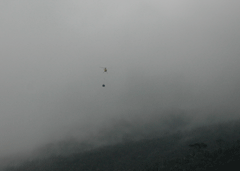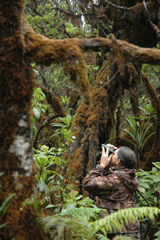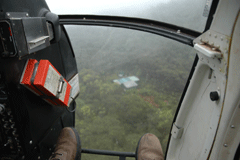The Way of the Dodo
Air Date: Week of August 1, 2008

The last known po’ouli, kept at the Bishop Museum in Honolulu. (Photo: Paul Baker)
Discovered only in 1973, by 2004 the population of the Hawaiian honeycreeper, known as the po'ouli had dwindled to a mere three birds. In "The Race to Save the World's Rarest Bird," science writer Alvin Powell recounts the bird's story. Host Bruce Gellerman talks with Mr. Powell about the surprising discovery of the bird and its untimely demise.
Transcript
GELLERMAN: It’s Living on Earth, I’m Bruce Gellerman.
[PO’OULI CALLS]
GELLERMAN: Listen closely…. Hear it?
[PO’OULI CALLS]
GELLERMAN: That’s the song of the Po’ouli - a small brown bird with a black mask, the size of a sparrow. The Po’ouli was discovered just 30 years ago. It was found on the Hawaian island of Maui on the steep, wet slopes of a volcanic rainforest. Back then there were 200 birds.
[PO’OULI CALLS]
GELLERMAN: And then…there were none.
[END PO’OULI CALLS]
GELLERMAN: The Po’ouli will never sing again. It’s extinct. Alvin Powell recounts the saga of the bird’s unusual discovery and the species’ demise in his new book, The Race to Save the World’s Rarest Bird: The Discovery and Death of the Po’ouli.

One of two choppers that brought conservationists into Hanawi during the summer of 2006. (Photo: Alvin Powell)
GELLERMAN: So in 1973 somebody spots a bird it looks like another type of bird but no, lo and behold, it’s this one.
POWELL: They called it the Mystery Bird because most of these people had never seen anything like it. There was kind of the thrill of discovery of the bird and then kind of the head-scratching, you know, what the heck do we have here? I mean Hawaii’s been settled for 1500 years, there was no record of this bird amongst the native people’s, there was no record in any of the bird literature, scientific literature, and it took awhile to figure out what exactly they had. At first the initial rush was almost natural tourism – they had a lot of people, a lot of scientists who were interested in birds going in just to really spot the thing. There wasn’t a lot of science done on the bird initially. And it really wasn’t until about ten years later when, a little bit more than ten years, when people working in the forest noticed a lot of damage to the forest from feral pigs that had been released and then they started to see that the bird’s numbers were declining and it was declared endangered within a couple of years under the new Endangered Species Act which was also passed that same year in 1973.

Kirsty Swinnerton, Maui Forest Bird Recovery Project Coordinator, views a bird during a 2006 trip into Hanawi. (Photo: Alvin Powell)
POWELL: It is, it’s quite extraordinary. And the rainforest does still harbor quite a few Hawaiian species, that’s one of the things that is extraordinary about it. When the Polynesians first arrived in Hawaii, all the islands were covered with native Hawaiian plants. And over time the lowlands were almost entirely converted to agriculture, the uplands have been slowly converted to pasture, and today much of Hawaii is introduced plants that we’ve brought there and decided should grow there—sugar cane or pineapple or whatever it is that we’d like. For Hawaiian forest birds, the highlands really are the only place to find them because among these introductions has been the introduction of the mosquito, which was never found on the Hawaiian Islands before. And the mosquito became a vector for bird diseases that had never been seen on the islands that wiped out birds across the lowlands below the area where the mosquito could breed.
GELLERMAN: The efforts to save this bird are enormous. It’s kind of amazing that one little tiny bird should get such attention actually and it takes a tremendous toll on the people who are trying to save it.
POWELL: It really does. And the people in this story, I mean it is the story of a bird, but in my mind one of the most compelling things about this story are the people who go out into this really extreme environment, it’s not just wet, it’s steep. The forest that’s there is very tangled, very dense - I spent a few days in there a couple years ago just to get a taste of it. And you talk about going on a trail through these forests and there’s really no trails what they do is they hang a piece of plastic flagging tape on a tree branch.

A view from above Alvin Powell’s camp in Hanawi. (Photo: Alvin Powell)
GELLERMAN: So what finally does the bird in?
POWELL: It seems it’s the accumulation of all these things just slowly hammering away at the bird. They believe it was once far more widespread than it is now, or was at the time that it was discovered, and that little by little it was pushed back, pushed back, pushed back. Scientists believe that in the rain, this very difficult rainforest where it was finally found, is actually not necessarily it’s ideal habitat and that perhaps this isn’t the ideal habitat to conserve them in and that’s perhaps part of the reason why it was so difficult. The last few birds died of old age, so you could say that old age did them in. And isolation – they are territorial birds. When I became aware of the po’ouli story several years ago there were still three birds around. But the birds were in separate home ranges, they were close to each other, but they were very territorial and they wouldn’t budge from their home ranges. So you had this tragic situation on this high rainy mountainside on Maui where the last three of this species are sitting there near each other, but in separate home ranges, perhaps not even aware of each other.
GELLERMAN: You write in the book about the veterinarian’s attempts to save the bird.
POWELL: That’s one of the most powerful things to me. This gentleman who was the head of the Maui Bird Conservation Center told me about leaving the bird - the bird had been sick for a short amount of time, and this was the last bird, they had captured the last bird in hopes of capturing, at the time there were three, in hopes of capturing the other two into a breeding center to do this last breeding. And the bird had become sick, they had tried everything, they tried a whole bunch of different intensive ways to keep the bird alive. And he told me that when he finally found it dead that he felt in some ways the weight of the world on him because he realized that they hadn’t been able to find the other two in the forest so this very likely was the last one but he also felt relief for this one sick individual. Not only was this bird possibly the last member of its species but it was also an individual and it had been this poor little bird subject to all sorts of invasive procedures and he just kind of felt a little bit of relief to kind of let it go at last.

This is the last known po’ouli. It is now kept at the Bishop Museum in Honolulu (Photo: Paul Baker)
POWELL: I think that some people have learned it, some of the people who are involved, were involved with the po’ouli are still involved with Hawaiian conservation. There is a program with the Maui parrot-bill which is another honeycreeper, there’s a couple hundred of these, they’re not waiting until they get down to very, very few, they have established a captive population and they are looking to establish a second wild population so that you’re not just dependant on this one bird. So I think some lessons have been done, this is one example. But Hawaii has one of the smallest land areas in the United States and it has, I believe, this largest population of threatened and endangered species right now. When you talk to biologists there even though it’s a state, it’s a part of this country, they kind of feel a little bit left out. They feel that a lot of the attention that these species often get passes by Hawaii even though it is kind of the hub of this sort of thing in the United States.
GELLERMAN: Do we have a responsibility, as a species, to save these other species?
POWELL: I believe we do. It’s not just one species, humanity, helping other species. I believe we have a responsibility to set right the things that we have sort of messed up and in Hawaii, certainly, much of the problems of the po’ouli if not all of them are because of introductions, of one kind or another, due to man. And again, we can expand this out around the world. One of the things that attracted me to this story was that this bird and the problems that it faced presented a lens through which to at the large extinction problem on Hawaii and also to look in a broader way at the global extinction crisis that we’re going through right now and I do believe that we have an obligation to do what we can to fix it.
GELLERMAN: Alvin Powell is a senior science writer in The Harvard University News Office. His book is called: The Race to Save the World’s Rarest Bird: The Discovery and Death of the Po’ouli.
Living on Earth wants to hear from you!
Living on Earth
62 Calef Highway, Suite 212
Lee, NH 03861
Telephone: 617-287-4121
E-mail: comments@loe.org
Newsletter [Click here]
Donate to Living on Earth!
Living on Earth is an independent media program and relies entirely on contributions from listeners and institutions supporting public service. Please donate now to preserve an independent environmental voice.
NewsletterLiving on Earth offers a weekly delivery of the show's rundown to your mailbox. Sign up for our newsletter today!
 Sailors For The Sea: Be the change you want to sea.
Sailors For The Sea: Be the change you want to sea.
 Creating positive outcomes for future generations.
Creating positive outcomes for future generations.
 Innovating to make the world a better, more sustainable place to live. Listen to the race to 9 billion
Innovating to make the world a better, more sustainable place to live. Listen to the race to 9 billion
 The Grantham Foundation for the Protection of the Environment: Committed to protecting and improving the health of the global environment.
The Grantham Foundation for the Protection of the Environment: Committed to protecting and improving the health of the global environment.
 Contribute to Living on Earth and receive, as our gift to you, an archival print of one of Mark Seth Lender's extraordinary wildlife photographs. Follow the link to see Mark's current collection of photographs.
Contribute to Living on Earth and receive, as our gift to you, an archival print of one of Mark Seth Lender's extraordinary wildlife photographs. Follow the link to see Mark's current collection of photographs.
 Buy a signed copy of Mark Seth Lender's book Smeagull the Seagull & support Living on Earth
Buy a signed copy of Mark Seth Lender's book Smeagull the Seagull & support Living on Earth

